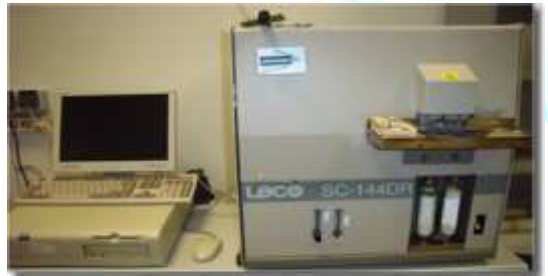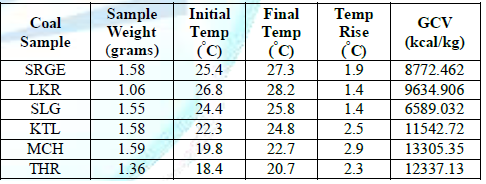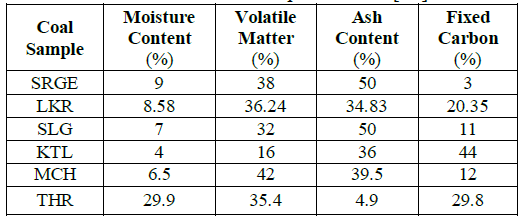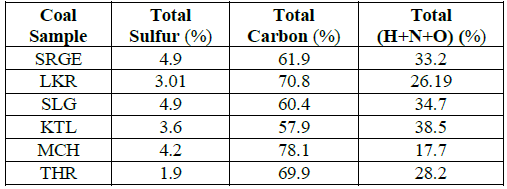Research Article :
Muhammad Saeed Ullah, Umair Zahid and Tariq Masood A
comparison of coal samples obtained from various regions of Pakistan was done
based on their proximate and ultimate analysis and gross calorific values to
discern the processing technique which may be applied for these coals e.g.
liquefaction, gasification, carbonization etc. The samples of coal were got
from different coal fields in Pakistan. Different nomenclature were chosen to
differentiate the regions of coal e.g., SRGE for coal obtained from Sor-Range
and Degari coalfields near Quetta, Baluchistan, LKR for coal obtained from
Lakhra, Sindh, SLGE for coal obtained from Salt Range coalfields near Chakwal,
Punjab, KTL for coal obtained from Kotli, Azad Jammu Kashmir (AJK), MCH for
coal obtained from Mach, Baluchistan and THR for coal sample obtained from
Tharparkar, Sindh. MCH coals were reported with highest calorific value of
13305.35kcal/kg. THR coals were classified as class (2) coals as they were
found with calorific values & carbon contents of 12337.13 kcal/kg and 69.9%
respectively. KTL coal samples were reported with lowest carbon contents of
57.9% in ultimate analysis experiments. MCH & SRG coals were nominated as
low quality coals because of their highest ash contents i.e., 50%. SRGE and SLG
coals were found hazardous for our ecosystem because of their high sulfur
contents. SRGE, LKR, SLG and THR were classified as class (2) bituminous coals
and were found best gas coals, while MCH and KTL were found class (1) and class
(4) bituminous coals respectively. Fossil fuels
like coal, petroleum and natural gas are nonrenewable sources of energy. They were formed from plants and animals remain (millions of years
ago) and their deposits are found beneath the earth. For this modern society
the demand of energy is increasing day by day. Fossil fuels are the
main source to meet our 85% of total demand of energy. Coal is supposed to
recoup its position as a major energy source. Basically coal is segregated into
four major classes; lignite, sub-bituminous, bituminous and
anthracite [1,2]. Coal is
combustible and carbonaceous solid that is obtained by decomposition of plants
because of pressure, temperature and compact force. We can differentiate the
types of coal from high rank to low rank according to their colors from brown
to black respectively. The source of vegetation contains from low plant forms
i.e., moss to significant woody plant precursors. Although the heating value is
provided by the carbon contents of coal, however the other factors such as
moisture contents, ash contents and sulfur contents play an important role for
defining the rank for a particular source of coal. The top ranked coal is
anthracite with highest contents of carbon e.g., 86-98% and having a calorific
value of ranges from 22-28 million BTU/ton. It contains low percentage of
volatile elements and is used for commercial and residual purposes. Bituminous
and Sub-bituminous coals have calorific values of ranges from 20-30 million
BTU/ton and 17-23.5 million Btu/ton respectively. These coals are present in
dark to dark brown colors and are commonly utilized as a fuel for energy
generation & metallurgical Purpose. The lowest rank of coal is lignite with
brown color; it is solely used as fuel for electricity generation. Lignite
coals have calorific values ranges from 9 to 17 million Btu/ ton [3]. In late 18th
century coal was commercially used by the north-western railways during
colonial regime after uncovering of coal in Balochistan area which is now a
province of Pakistan. At present total coal reserves of Pakistan are estimated
about 184.5 billion tons including newly discovered deposits of Thar coal having lower
contents of sulfur. Various minerals are associated with the composition of
coal; the combustion of coal produces notable amounts of solid residues such as
fly ash. While transportation or disposal operations these wastes are come into
contact with water leading to leaching out the various toxic elements such as
nickel, lead, cadmium, zinc, chromium and mercury from the ashes which
contaminate the ground water and soil. While the other inorganic constituents
such as potassium, sodium and zirconium associated with minerals are present in
trace amounts in coal [4,5]. In various
environmental substances like soil, air and water, different amounts of both
necessary and toxic metals are available. The real amounts of these metals in living bodies
depends on various factors such as the actual concentration in that area, the
food pattern, industrial circumstances and the most common profession of the
people of that area [6,7]. The
combustion of coal as a fuel emits various toxic elements such as CO2,
SOx, NOx and some volatile inorganic elements (especially
As, Be, Cd, Co, Cr, Hg, Mn, Ni, Pb, Sb, Se) and their compounds in flu gas.
These emissions may have critical effects on our eco system like globally
increase in temperature and head-on hazards to agricultural lands, water and
human health. There are also various types of land pollutions like inorganic
constituents in fly ash, bottom and slag disposed. After releasing into the
environment these pollutants may lead to various chemical reactions which may
transform them into different hazardous compounds. To investigate the presence
of these inorganic elements in coal samples, Atomic Absorption Spectrophotometric Analysis was used particularly although there are large reserves of coal in
Pakistan, but there is an essential need to be utilized for development of
country. Sindh province is the richest region of Pakistan with respect to coal
reserves e.g., 175 billion tons of lignite coal is located in Thar region of
Sindh. Pakistan is world’s 7th country in having reserves of lignite coal. It is
estimated that Thar coal has a great potential for electricity production such
as 100,000 MW at consumption of 536 million tons per year. Although Thar coal
has lowest sulfur content, still it needs to be developed for mining and
generation of energy because of economic and environmental aspects [8-11]. Additionally
to Thar coal reserves, there are lignite coal reserves located in various
regions of Pakistan i.e., Sonda Indus East, Lakhra and other areas of Sindh.
Bituminous and good quality sub-bituminous coals can be utilized for
electricity generation and their reserves in large amounts are located in
different coalfields of Punjab and Baluchistan provinces of Pakistan. Other
coal reserves available in KPK and AJK regions of Pakistan are being mined in
smaller amounts. As Pakistan is importing coal for its steel, cement and power
industry on a large scale from Indonesia, Afghanistan and other countries,
these expenditure can be saved and utilized for research and development
purposes if we will develop feasible and useful process to utilize our local
coal . It is essential to develop local coal reserves in
Pakistan as demand for energy is increasing day by day due to the population
increase and modernization of the world. There is an inevitable demand to
define the feasible and environmental friendly methods of utilizing the local
coal reserves. In this research article addition to compare the environmental
impacts of coal samples from various regions of Pakistan, the proximate and
ultimate analysis were done to characterize the samples and to investigate
their industrial applications [12,13]. Figure 1: LECO SC-144DR Sulphur-Carbon Analyzer Six coal
samples were obtained in the form of lumps; their sizes were in ranges from
400-500 grams per piece. In order to obtain the required size of coal samples
for determination of calorific value, Ultimate and Proximate analysis, and coal
samples were crushed down using a hammer following pulverization of crushed
coals separately in an end runner mill until a size of -72 B.S mesh. To avoid
cross contamination due to finer size of samples, various preventive steps have
been followed. After each sample every sieve was cleaned with water and dried
over a gas heater. In the same manner the bowl and pestle of end runner mill
was cleaned using a wet cloth after using for each sample. All of the six
samples were stored in a cool and dry place after pouring them into air tight
Ziploc bags in order to prevent from any excessive moisture contents. The most
commonly used method for analysing the coal samples is proximate analysis in
which volatile matter, moisture contents, ash contents and fixed carbon are
determined. The quality and rank of coal are assessed generally by proximate
analysis. Using bomb calorimeter calorimetric analysis
was performed to determine the energy exchange between the reaction system and
the environment. Elemental
analysis also called ultimate analysis is used to design the coal burning
equipment and auxiliaries. Usually weight percentages of carbon, nitrogen,
hydrogen, oxygen and sulfur are determined in ultimate analysis. Due to
unavailability of analysis equipment, in this research study only sulfur and
carbon contents in each sample were determined using a LESCO SC-144DR analyzer
following ASTM 5016-08 method. This analysis starts as a sample (0.350gm
nominal) is weighed into a combustion boat. The sample within the combustion
boat is placed in a pure oxygen environment typically regulated at 1350 °C, and
then undergoes complete combustion, releasing the sample’s carbon as carbon
dioxide gas and sulphur as sulphur dioxide. The sample’s
combustion gases are first swept through the boat stop to the back on the inner
combustion tube, then forward between the inner and outer tubes, allowing the
combustion gases to remain in the high temperature zone for a longer period and
permit efficient oxidation. From the combustion system, the gases flow through
two anhydrous tubes removing moisture, through a flow controller that set the
flow of the combustion gases through the infrared detection cell. The carbon IR
cell measures the concentration of carbon dioxide gas. The sulphur IR cell
measures the concentration of sulphur dioxide gas. The LECO SC-144DR analyzer
is controlled by an external PC using a windows-based operating system. Calorimetry of the coals Calorimetry
results were performed and MCH coals were found with maximum calorific values
i.e., 13305.35 kcal/kg. THAR coals were also found with comparable calorific
value while the lowest value was determined for SLG coal samples. Table 1: The results of the Calorimetry of the coal. Proximate analysis of the coals: Proximate analysis of all coal samples was
performed. The maximum carbon contents were found in THAR coal samples while
the lowest carbon contents were investigated for SRG coals. MCH & SRG coals
were nominated as low quality coals because of their highest ash contents i.e.,
50%. Ultimate analysis of the coals: The results of ultimate analysis have shown
that SRG and SLG coals are not suitable to use them as fuel because of their
without sulfur removal as they contain high percentage of sulfur i.e., 4.9%.THR
coals were found best because they contain less sulfur contents and highest
carbon contents. Lowest carbon contents were found in KTL coal samples that
were 57.9%. According to the
standard table suggested by Regnault-Grüner-Brosquet (table 4), coal samples were classified. SRG, LKR, SLG and THR are
bituminous class (2) coals which yields 32 – 40% volatile matter and a porous coke
of moderate strength at 900⁰C. While MCH is a bituminous coal of class-1. It is
a Super bituminous coal that yields at 900⁰C more than 40% of volatile matter
and a non-coherent carbonaceous residue. Although KTL is a class (4) coal as
its volatile matter content is 16% but its moisture content is the lowest out of
the six samples i.e. 4% [14]. Table 2: The results of the proximate analysis of the coal. Table 3: The results of the ultimate analysis of the coal. Table 4: Classification of coal (Regnault-Grüner-Brosquet Standard Tab. From the
above discussion it was concluded that SRG, LKR, SLG and THR are bituminous
class (2) coals. These coals are the best gas-coals. They burn with a long
luminous flame, and on distillation pass through a stage of intumescences,
during which gas is freely expelled. Although THR coal has the lowest sulphur
contents i.e. 1.9%, still there is a need to remove sulphur contents by Claus’s
process during a stage in coal liquefaction. MCH being a class (1) bituminous
coals burn with a very long and highly luminous smoky flame and for that reason
are chiefly valued for the firing of reverberator furnaces and the like. They
are also used to some extent as house coals, because of their free burning
qualities. They are not, however, good for steam rising, and their non-caking
character renders them quite useless for coke manufacture. KTL are class (4)
bituminous coals & having low moisture contents i.e. 4%. Coal gasification
requires low moisture content of coal; KTL may be used for this process as its
moisture content is the lowest out of the 6 samples. They are caking coals and
therefore, they may be used in carbonization. 1.
Saeed K,
Ishaq M, Ahmad I and Park SY. Characterization and evaluation of Thar coal for
different mineral contents (2006) Journal Chem Society Pakistan 28: 207-210. 2.
Satti
SL, Hassan MS, Mehmood H and Shahbaz M. Coal Consumption: An Alternate
EnergyResource to Fuel Economic Growth in Pakistan (2013) Munich Personal RePEc
Archive. 3.
Mukherjee
S and Borthakur PC. Effects of alkali treatment on ash and sulfur removal from
Assam coal (2003) Journal Fuel Proc Tech 85: 93-101 4.
Malkani
MS et al., Coal resources of Pakistan: new coal fields (2016) J Sci Techl 5:
7-22. 5.
Fu B et
al. Emission and transformation behavior of minerals and hazardous trace
elements (HTEs) during coal combustion in a circulating fluidized bed boiler
(2018) J Environmental Pollution 242: 1950-1960. https://doi.org/10.1016/j.envpol.2018.07.066. 6.
Khan M,
Ahmad I and Akhtar G. Characterization and Comparative Study of Pakistani Coals
by Liquids Adsorption Methods (2005) J Chemical Society of Pakistan 27:
580-584. 7.
Wahid F
et al. Characterization of Coal Samples from Dasal-I Coal Mine (2012) J
Chemical Society of Pakistan 34: 1274-1278. 8.
Xu M et
al. Status of trace element emission in a coal combustion process: a review
(2003) J Energy and Environment, Fuel Processing Tech 85: 215: 237. https://doi.org/10.1016/s0378-3820(03)00174-7. 9.
Tian HZ
et al. A Review of Key Hazardous Trace Elements in Chinese Coals: Abundance,
Occurrence, Behavior during Coal Combustion and Their Environmental Impacts
(2013) Energy Fuels 27: 601-614. https://doi.org/10.1021/ef3017305. 10.
Ullah MS
and Saleemi H. Desulfurization and Parametric Study of Bituminous Coal Via
Froth Flotation Technique (2017) International J Advanced Biotechnology and
Research (IJBR) 8: 237-245. 11.
Krishnan
MS. Classification of coal (1940) Geological Survey of India. 12.
Malkani
MS. A Review of Coal and Water Resources of Pakistan (2012) J of Sci Tech and
Dev 31: 202-218. 13.
Liu G et
al. Enrichment and distribution of trace elements in Padhrar, Thar and Kotli
coals from Pakistan: Comparison to coals from China with an emphasis on the
elements distribution (2018) J Geochemical Exploration 185: 153-169. 14.
Thomas
RE et al. Coal resources of the Sonda coal field, Sindh Province (1993)
Pakistan International J Coal Geology 23: 159-191. https://doi.org/10.1016/0166-5162(93)90047-e. Muhammad
Saeed Ullah, Institute of Chemical Engineering & Technology, University of
the Punjab, Lahore, Pakistan, Email: engrsaeed147@gmail.com Ullah SM, Zahid U and Masood T. Ultimate and proximate analysis of coal
samples from different regions in Pakistan for their future utilization (2019)
J of Heterocyclics 1: 39-41. Characterization of coal, processing of coal,
Proximate and ultimate analysis of coal, Potential utilization.Ultimate and Proximate Analysis of Coal Samples from Different Regions in Pakistan for their Future Utilization
Abstract
Full-Text
Introduction

Materials and Method
Results

Discussion



Conclusion
References
*Corresponding
author
Citation
Keywords